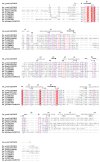Crystal Structure of a Hidden Protein, YcaC, a Putative Cysteine Hydrolase from Pseudomonas aeruginosa, with and without an Acrylamide Adduct
- PMID: 26184183
- PMCID: PMC4519933
- DOI: 10.3390/ijms160715971
Crystal Structure of a Hidden Protein, YcaC, a Putative Cysteine Hydrolase from Pseudomonas aeruginosa, with and without an Acrylamide Adduct
Abstract
As part of the ongoing effort to functionally and structurally characterize virulence factors in the opportunistic pathogen Pseudomonas aeruginosa, we determined the crystal structure of YcaC co-purified with the target protein at resolutions of 2.34 and 2.56 Å without a priori knowledge of the protein identity or experimental phases. The three-dimensional structure of YcaC adopts a well-known cysteine hydrolase fold with the putative active site residues conserved. The active site cysteine is covalently bound to propionamide in one crystal form, whereas the second form contains an S-mercaptocysteine. The precise biological function of YcaC is unknown; however, related prokaryotic proteins have functions in antibacterial resistance, siderophore production and NADH biosynthesis. Here, we show that YcaC is exceptionally well conserved across both bacterial and fungal species despite being non-ubiquitous. This suggests that whilst YcaC may not be part of an integral pathway, the function could confer a significant evolutionary advantage to microbial life.
Keywords: X-ray crystallography; YcaC; isochorismate family; micro-crystals; molecular replacement; protein octamer.
Figures



References
-
- Henwood C.J., Livermore D.M., James D., Warner M. Antimicrobial susceptibility of Pseudomonas aeruginosa: Results of a UK survey and evaluation of the British Society for antimicrobial chemotherapy disc susceptibility test. J. Antimicrob. Chemother. 2001;47:789–799. doi: 10.1093/jac/47.6.789. - DOI - PubMed
-
- Vasil M.L., Stonehouse M.J., Vasil A.I., Wadsworth S.J., Goldfine H., Bolcome R.E., III, Chan J. A complex extracellular sphingomyelinase of Pseudomonas aeruginosa inhibits angiogenesis by selective cytotoxicity to endothelial cells. PLoS Pathog. 2009;5:e1000420. doi: 10.1371/journal.ppat.1000420. - DOI - PMC - PubMed
-
- Truan D., Vasil A., Stonehouse M., Vasil M.L., Pohl E. High-level over-expression, purification, and crystallization of a novel phospholipase C/sphingomyelinase from Pseudomonas aeruginosa. Protein Expr. Purif. 2013;90:40–46. doi: 10.1016/j.pep.2012.11.005. Erratum in 2015, 108, 115. - DOI - PMC - PubMed
-
- Pseudomonas Genome Database. [(accessed on 26 June 2015)]. Available online: http://www.pseudomonas.com.
Publication types
MeSH terms
Substances
Grants and funding
LinkOut - more resources
Full Text Sources
Other Literature Sources
Research Materials

